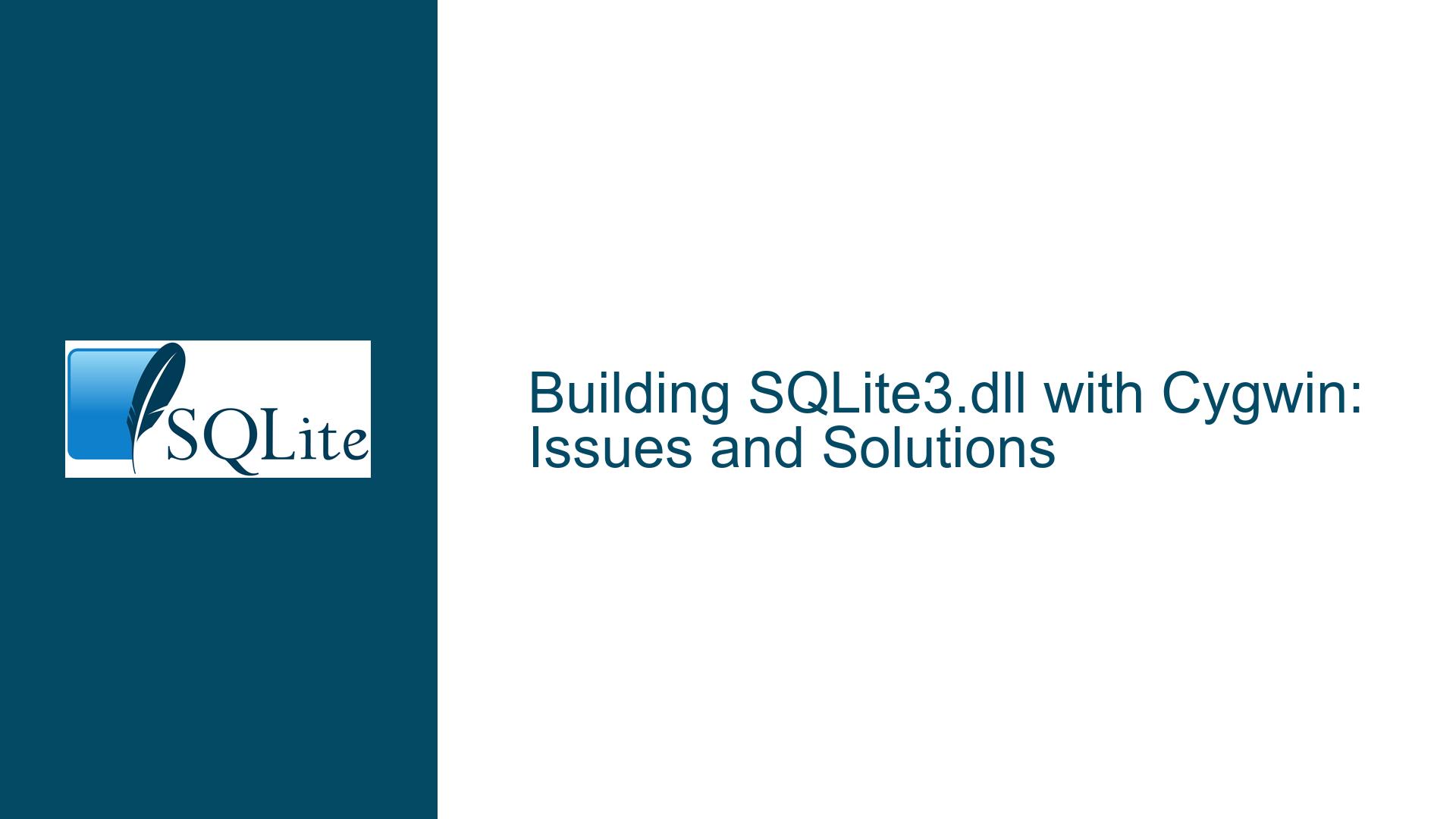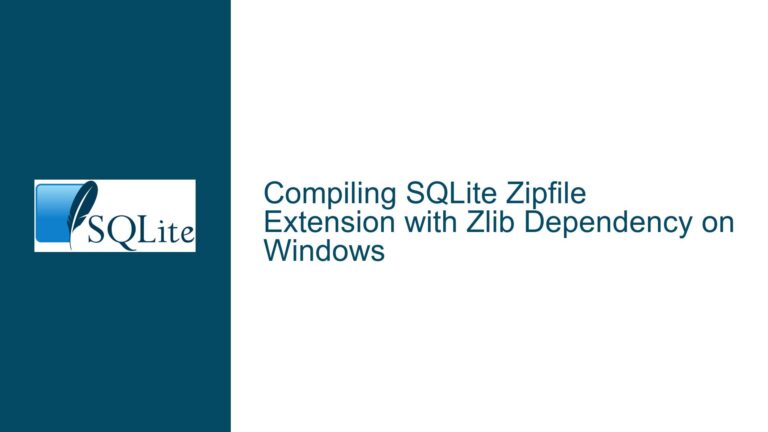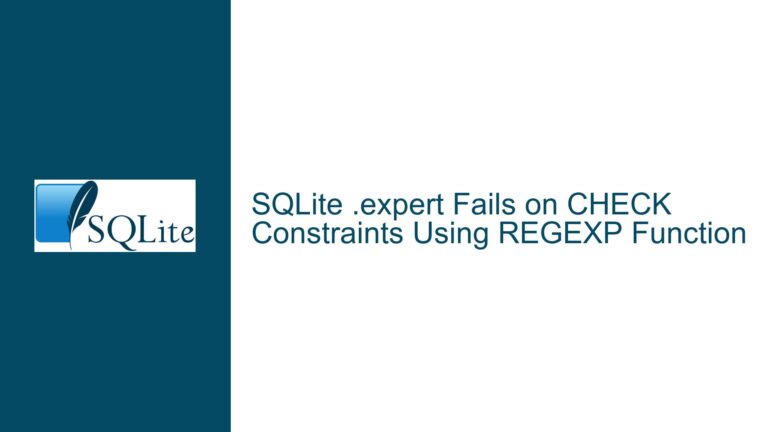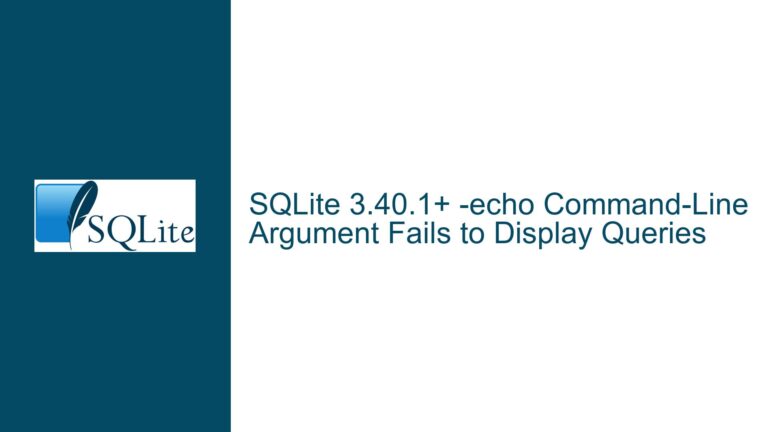Building SQLite3.dll with Cygwin: Issues and Solutions
Understanding the SQLite3.dll Compilation Process in Cygwin
When working with SQLite on Windows using Cygwin, one of the common tasks is to compile the SQLite3.dll file. This dynamic link library (DLL) is essential for applications that need to interact with SQLite databases on Windows. However, the process of generating this DLL can be fraught with challenges, especially when using the ./configure and make commands in a Cygwin environment. The primary issue revolves around the generation of the SQLite3.dll file, which may not be created by default, or if created, may depend on Cygwin libraries, making it non-standalone.
The compilation process involves several steps, starting with the configuration of the build environment using ./configure, followed by the actual compilation using make. The ./configure script generates a Makefile tailored to the specific environment and options provided. The make command then uses this Makefile to compile the source code into the desired output, such as executables or DLLs. However, the default behavior of these commands may not always align with the user’s expectations, particularly when it comes to generating a standalone SQLite3.dll file that does not rely on Cygwin libraries.
Identifying the Root Causes of SQLite3.dll Compilation Issues
The core issue in generating the SQLite3.dll file using Cygwin can be attributed to several factors. First, the default target in the generated Makefile may not include the creation of the SQLite3.dll file. This means that even if the make command is executed, it may not produce the desired DLL unless explicitly instructed to do so. The Makefile contains various targets, each corresponding to a specific output file or set of files. If the SQLite3.dll target is not included in the default set of targets, it will not be built unless explicitly specified.
Another significant factor is the dependency on Cygwin libraries. When the SQLite3.dll file is generated, it may be linked against Cygwin’s dynamic libraries, which means that the resulting DLL will require these libraries to be present on the system where it is deployed. This dependency can be problematic if the goal is to create a standalone DLL that can be used on any Windows system without requiring additional Cygwin components. The linkage against Cygwin libraries is typically controlled by the compiler and linker flags used during the build process. If these flags are not set correctly, the resulting DLL will have unwanted dependencies.
Additionally, the configuration options passed to the ./configure script can significantly impact the build process. The ./configure script is responsible for setting up the build environment, including the selection of the compiler, the setting of compiler and linker flags, and the definition of various build parameters. If the correct options are not provided to the ./configure script, the resulting Makefile may not be configured to produce a standalone SQLite3.dll file. For example, the --host option is used to specify the target platform, and the CFLAGS and LDFLAGS options can be used to pass additional compiler and linker flags.
Resolving SQLite3.dll Compilation Issues: Step-by-Step Solutions
To address the issues related to the compilation of the SQLite3.dll file in Cygwin, a systematic approach is required. The following steps outline the process of generating a standalone SQLite3.dll file that does not depend on Cygwin libraries.
Step 1: Specifying the Correct Target in the Make Command
The first step is to ensure that the make command is instructed to build the SQLite3.dll file. By default, the make command will build the default target specified in the Makefile, which may not include the SQLite3.dll file. To explicitly build the SQLite3.dll file, the make command should be invoked with the appropriate target:
make sqlite3.dll
This command tells make to build the SQLite3.dll target, which should result in the generation of the DLL file. However, if the Makefile does not include a target for SQLite3.dll, this command will fail. In such cases, it may be necessary to modify the Makefile or provide additional options to the ./configure script to ensure that the SQLite3.dll target is included.
Step 2: Configuring the Build Environment for Standalone DLL Creation
To create a standalone SQLite3.dll file that does not depend on Cygwin libraries, it is essential to configure the build environment correctly. This involves passing the appropriate compiler and linker flags to the ./configure script. The CFLAGS and LDFLAGS environment variables can be used to specify these flags:
./configure --host=i686-w64-mingw32 CFLAGS="-shared -static-libgcc" LDFLAGS="-static-libgcc"
In this command, the --host option specifies the target platform as i686-w64-mingw32, which is a 32-bit Windows target. The CFLAGS option is used to pass the -shared flag, which instructs the compiler to generate a shared object (DLL), and the -static-libgcc flag, which ensures that the GCC runtime libraries are statically linked. The LDFLAGS option is used to pass the -static-libgcc flag to the linker, ensuring that the resulting DLL does not depend on Cygwin’s dynamic libraries.
Step 3: Building the SQLite3.dll File
Once the build environment is configured correctly, the next step is to build the SQLite3.dll file using the make command. The following command can be used to build both the SQLite3.dll file and the SQLite3.exe executable:
make sqlite3.dll sqlite3.exe
This command instructs make to build both the SQLite3.dll and SQLite3.exe targets. The resulting SQLite3.dll file should be a standalone DLL that does not depend on Cygwin libraries, while the SQLite3.exe executable should also be standalone.
Step 4: Verifying the Standalone Nature of the Generated DLL
After the build process is complete, it is essential to verify that the generated SQLite3.dll file is indeed standalone and does not depend on Cygwin libraries. This can be done using the ldd command, which lists the dynamic dependencies of a binary file:
ldd sqlite3.dll
If the SQLite3.dll file is standalone, the output of the ldd command should not list any Cygwin libraries. If Cygwin libraries are listed, it indicates that the DLL still depends on them, and further adjustments to the build configuration may be necessary.
Step 5: Troubleshooting Common Issues
If the SQLite3.dll file is not generated as expected, or if it still depends on Cygwin libraries, several troubleshooting steps can be taken. First, ensure that the ./configure script is invoked with the correct options, as described in Step 2. If the options are correct, but the issue persists, it may be necessary to inspect the generated Makefile to ensure that the correct compiler and linker flags are being used.
Another common issue is the presence of conflicting environment variables or incorrect PATH settings. Ensure that the correct version of the compiler is being used by checking the CC environment variable and the PATH. If necessary, explicitly set the CC variable to the correct compiler:
export CC=i686-w64-mingw32-gcc
Additionally, ensure that the CFLAGS and LDFLAGS variables are set correctly and are being passed to the ./configure script. If the issue persists, it may be helpful to manually edit the Makefile to add the necessary flags.
Step 6: Advanced Configuration and Customization
For more advanced users, additional customization of the build process may be necessary. This can include modifying the ./configure script or the Makefile to add custom build targets or to adjust the build parameters. For example, if the SQLite3.dll target is not included in the Makefile, it may be necessary to add it manually. This can be done by adding a new target to the Makefile:
sqlite3.dll: sqlite3.c
$(CC) $(CFLAGS) -shared -static-libgcc -o sqlite3.dll sqlite3.c $(LDFLAGS)
This target instructs make to build the SQLite3.dll file using the specified compiler and linker flags. Once the target is added, the make sqlite3.dll command should work as expected.
Step 7: Finalizing the Build and Deployment
Once the SQLite3.dll file is successfully generated and verified to be standalone, the final step is to deploy it to the target system. Ensure that the DLL is placed in a location where it can be accessed by the application that requires it. Additionally, ensure that any necessary header files and import libraries are also included in the deployment package.
In conclusion, the process of generating a standalone SQLite3.dll file using Cygwin involves careful configuration of the build environment, explicit specification of build targets, and thorough verification of the resulting DLL. By following the steps outlined above, users can overcome the common challenges associated with this process and successfully create a standalone SQLite3.dll file for use on Windows systems.






